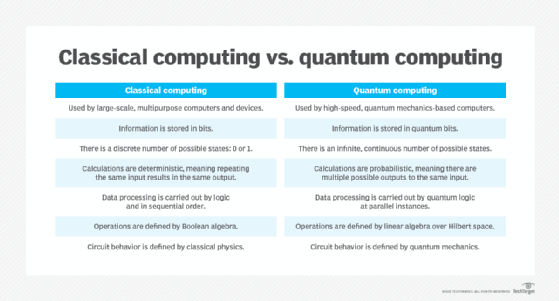Classical vs. quantum computing: What are the differences? (original) (raw)
As new technologies develop and gain traction, the public tends to divide into two groups: those who believe it will make an impact and grow, and those who don't. The former tends to be correct, so it is crucial to understand how future technologies differ from the status quo to prepare for their adoption en masse.
Classical computing has been the norm for decades, but in recent years, quantum computing has continued to rapidly develop. The technology is still in its early stages, but has existing and many more potential uses in AI/ML, cybersecurity, modeling and other applications.
It might be years before widespread implementation of quantum computing. However, explore the differences between classical vs. quantum computing to gain an understanding should the technology become more widespread.
Differences between classical computing vs. quantum computing
Quantum computers typically must operate under more regulated physical conditions than classical computers because of quantum mechanics. Classical computers have less compute power than quantum computers and cannot scale as easily. They also use different units of data -- classical computers use bits and quantum computers use qubits.
Units of data: Bits and bytes vs. qubits
In classical computers, data is processed in a binary manner.
Classical computers use bits -- eight units of bits is referred to as one byte -- as their basic unit of data. Classical computers write code in a binary manner as a 1 or a 0. Simply put, these 1s and 0s indicate the state of on or off, respectively. They can also indicate true or false or yes or no, for example.
This is also known as serial processing, which is successive in nature, meaning one operation must complete before another one follows. Lots of computing systems use parallel processing, an expansion of classical processing, which can perform simultaneous computing tasks. Classical computers also return one result because bits of 1s and 0s are repeatable due to their binary nature.
Quantum Computing: 4 Things You Need to Know

3:53
Quantum computing, however, follows a different set of rules. Quantum computers use qubits as their unit of data. Qubits, unlike bits, can be a value of 1 or 0, but can also be 1 and 0 at the same time, existing in multiple states at once. This is known as superposition, where properties are not defined until they are measured.
According to IBM, "Groups of qubits in superposition can create complex, multidimensional computational spaces," which enables more complex computations. When qubits become entangled, changes to one qubit directly affect the other, which makes information transfer between qubits much faster.
In classical computers, algorithms need a lot of parallel computations to solve problems. Quantum computers can account for multiple outcomes when they analyze data with a large set of constraints. The outputs have an associated probability, and quantum computers can perform more difficult compute tasks than classical computers can.
Power of classical vs. quantum computers
Most classical computers operate on Boolean logic and algebra, and power increases linearly with the number of transistors in the system -- the 1s and 0s. The direct relationship means in a classical computer, power increases 1:1 in tandem with the transistors in the system.

Because quantum computers' qubits can represent a 1 and 0 at the same time, a quantum computer's power increases exponentially in relation to the number of qubits. Because of superposition, the number of computations a quantum computer could take is 2N where N is the number of qubits.
Operating environments
Classical computers are well-suited for everyday use and normal conditions. Consider something as simple as a standard laptop. Most people can take their computer out of their briefcase and use it in an air-conditioned café or on the porch during a sunny summer day. In these environments, performance won't take a hit for normal uses like web browsing and sending emails over short periods of time.
Organizations that don't plan on implementing quantum computing in their own business will still need to prepare for the external threats quantum computing might impose.
Data centers and larger computing systems are more complex and sensitive to temperature, but still operate within what most people would consider "reasonable" temperatures, such as room temperature. For example, ASHRAE recommends A1 to A4 class hardware stays at 18 to 27 degrees Celsius, or 64.4 to 80.6 degrees Fahrenheit.
Some quantum computers, however, need to reside in heavily regulated and stringent physical environments. Some need to be kept at absolute zero, which is around -273.15 degrees Celsius or -459.67 Fahrenheit, although recently the first room-temperature computer was developed by Quantum Brilliance.
The reason for the cold operating environments is that qubits are extremely sensitive to mechanical and thermal influences. Disturbances can cause the atoms to lose their quantum coherence -- essentially, the ability for the qubit to represent both a 1 and a 0 -- which can cause errors to computations.
Why data center managers should take note of quantum computing
Like most technologies, quantum computing poses opportunities and risks. While it might be a while before quantum computers really take off, start to have conversations with leadership and develop plans for quantum computing.
Organizations that don't plan on implementing quantum computing in their own business will still need to prepare for the external threats quantum computing might impose. Firstly, quantum computers can potentially crack even the most powerful and advanced security measures. For example, a motivated enough hacker can, in theory, use quantum computing to quickly break the cryptographic keys commonly used in encryption if they are savvy.
In addition, organizations that are considering quantum computers for their data centers or certain applications will have to prepare facilities. Like any other piece of infrastructure, quantum computers need space, electricity supply and resources to operate. Begin examining the options available to accommodate for them. Look at budget, space, facility and staffing needs to begin planning.